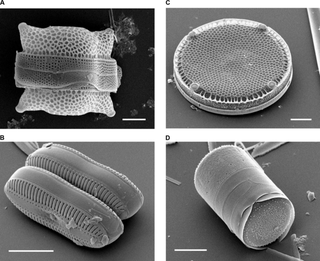
Everyday I hear about a new use for diatomaceous earth. It's in everything! And still, not very many people have heard about DE or know what a "diatom" is. Here's a special guest blog by Esther Inglis-Arkell from io9.com that gets into DE, diatoms and how important this mineral today. (Note: Ms. Inglis-Arkell does refer to a diatom as an animal, when in fact it is a microscopic unicellular plant.)
Many animals have been useful to humankind. Dogs have hunted with us. Horses have carried us around and plowed our fields. Cats have ... I don't know. It'll come to me. In any case, perhaps the most useful animals in the modern world performed their service by dying thousands of years ago.
These animals are diatoms. Single-celled organisms, their living relatives still roam the ocean alone or in colonies, protected only by a fragile cell made of silicon dioxide. It's no surprise that they died in droves, and their leftover skeletons made deposits that are now mined for a remarkable, but ubiquitous, substance.
Diatomaceous earth, named for the animals that created it, is the crushed up shells of diatoms. As it's spring, many people are out buying bags of it right now. For humans, it's completely harmless For insects, it's some of the most vicious stuff ever created. The silicon dioxide in diatomaceous earth, is like little shards of glass. It scratches the insects' shells, and stays there. Unlike glass, the earth is incredibly porous, and so extremely absorbent. Give an insect enough time exposed to diatomaceous earth, and the juices literally get sucked out of it. Bugs dehydrate and die. That's right, touching diatomaceous earth is to insects what drinking from the wrong holy grail is to humans. They turn to wizened corpses right in front of us.

We, on the other hand, are so unfazed by the stuff that some people eat it during cleanses. While this probably isn't a great idea, everyone has swallowed some of it. It's in toothpaste, it's used in hydroponic experiments, it's sometimes dusted over pasta to keep bugs away, and it's fed to animals as a marker in nutrition experiments. Because it's so harmless to humans, it's used as a drying agent or scrubbing agent in everything from cat litter to cleaning products. Basically, you've unknowingly lived your life surrounded by the ground up fossils of diatoms.
Most of these applications are somewhat pedestrian (Unless you get a good, up-close view of the widespread massacre of the insects. That has to be pretty brutal.) but these ancient creatures took a step into the future. They're one of the best ways to purify DNA.
The same spikes and pores that make diatomaceous earth a bug killer makes it irresistible to DNA. It helps that DNA has a bit of an affinity for silicon dioxide. After cells have been split open, and the DNA lies intertwined with their other guts, the diatomaceous earth is mixed into the solution. The whole thing needs a little pH tweaking - both silicon dioxide and DNA have a slightly negative charge that would keep them apart - but once the charge is changed, the DNA grabs hold of the silicon dioxide. The many pits and hollows in the diatomaceous earth keep hold of DNA while everything else is washed away. Another tweak to the solution, and the DNA lets go, purified and isolated by what is essentially fancy dirt.
So single-celled creatures that died long ago have formed a substance that is, quietly, everywhere. It shapes the modern world, and will probably contribute to the future of medicine and biological research. Forget quadrupeds as pets. Give up your cats and dogs, and perhaps, adopt some diatoms.
To learn more about DE and its amazing uses, please visit https://epminerals.com/minerals.
